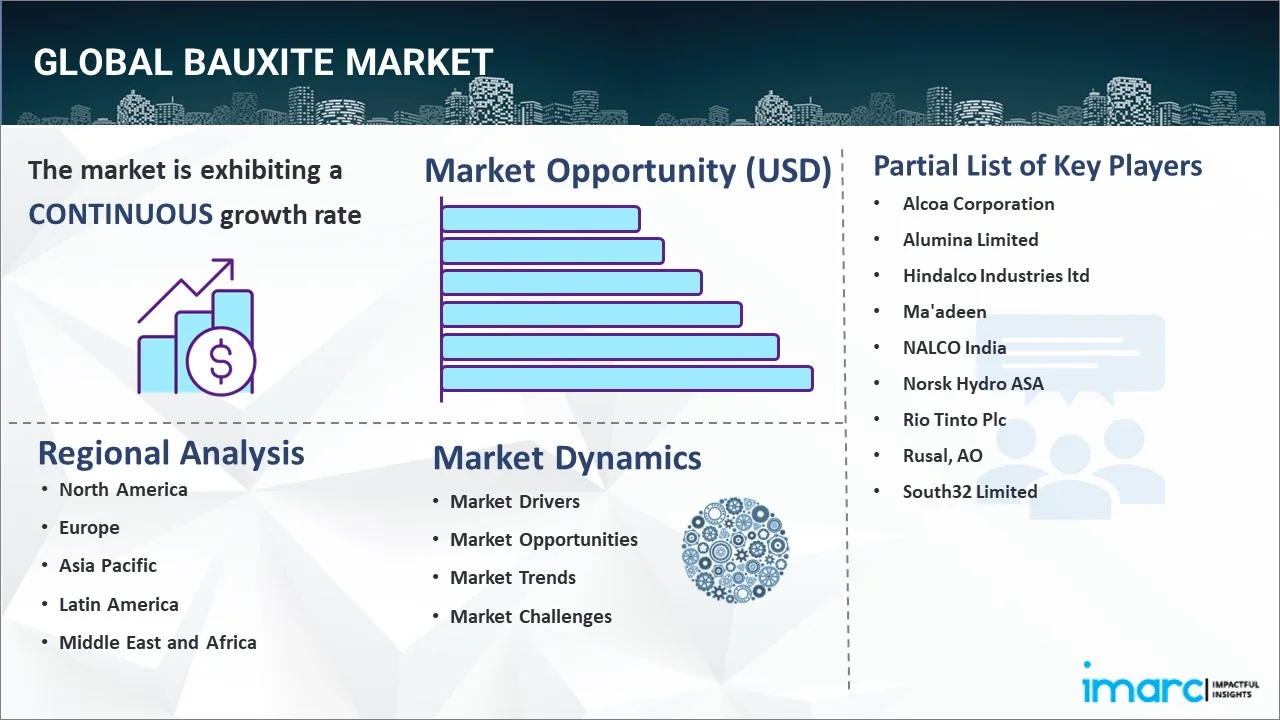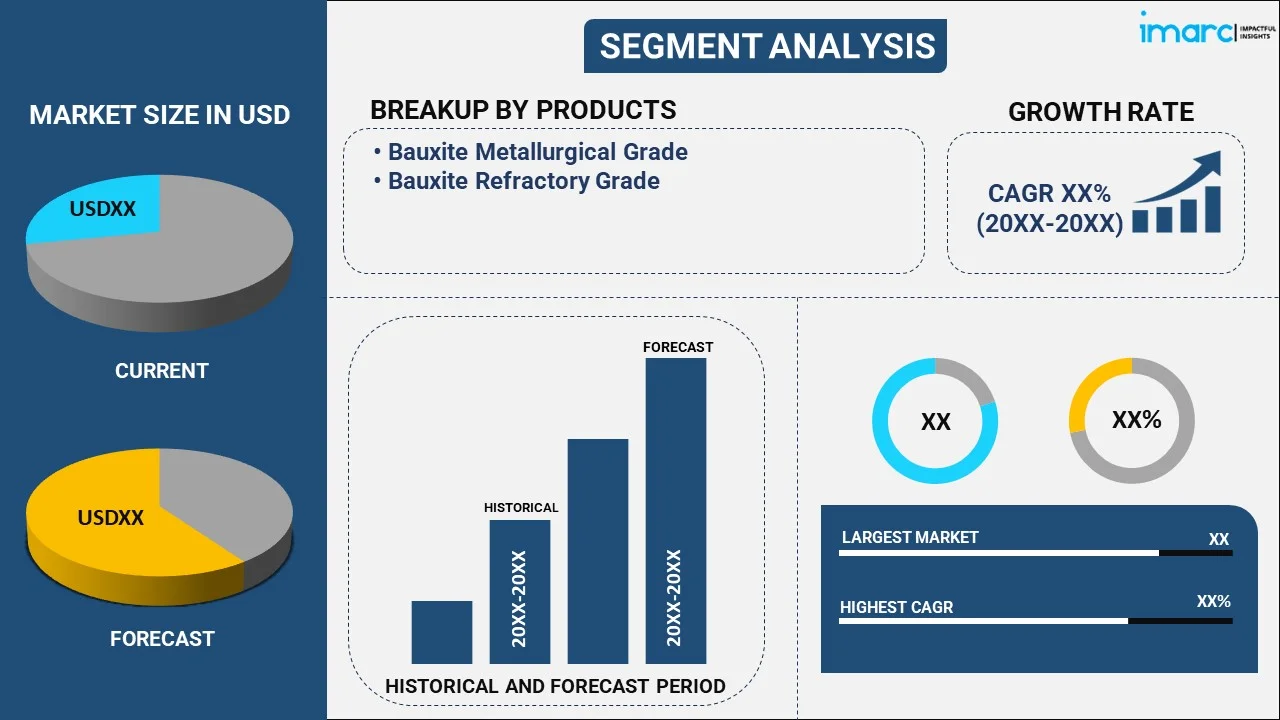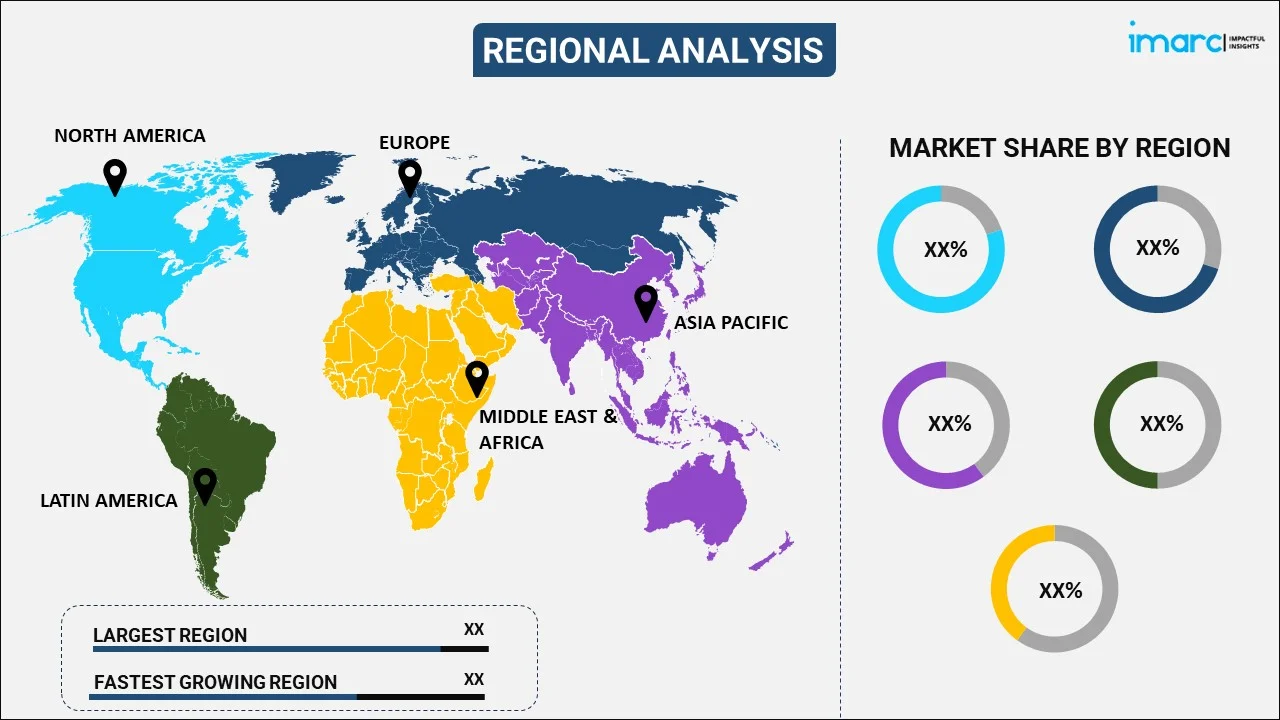
Bauxite Market Report by Product (Bauxite Metallurgical Grade, Bauxite Refractory Grade), Application (Alumina Production, Refractory, Cement, and Others), and Region 2025-2033
Bauxite Market Overview:
The global bauxite market size reached USD 16.7 Billion in 2024. Looking forward, IMARC Group expects the market to reach USD 21.4 Billion by 2033, exhibiting a growth rate (CAGR) of 2.94% during 2025-2033. The market is experiencing steady growth driven by the growing demand for aluminum for various industries, rising number of infrastructure projects, increasing adoption of electric vehicles (EVs) among people, and innovations in mining technology.
|
Report Attribute
|
Key Statistics
|
|---|---|
|
Base Year
|
2024 |
|
Forecast Years
|
2025-2033
|
|
Historical Years
|
2019-2024
|
| Market Size in 2024 | USD 16.7 Billion |
| Market Forecast in 2033 | USD 21.4 Billion |
| Market Growth Rate (2025-2033) | 2.94% |
Bauxite Market Analysis:
- Market Growth and Size: The bauxite market size is witnessing stable growth, driven by the increasing demand for aluminum in several sectors, along with the rapid urbanization.
- Technological Advancements: Technological innovations in bauxite mining and refining processes assist in enhancing efficiency, reducing costs, and improving sustainability. In addition, there is a rise in the adoption of automation, digitalization, and eco-friendly mining practices in the bauxite industry.
- Industry Applications: Bauxite is a critical raw material for aluminum production, which finds applications in the aerospace, automotive, construction, and packaging industries. Moreover, the increasing focus on sustainable practices is bolstering the market growth.
- Geographical Trends: Asia Pacific leads the market, driven by the rising number of energy projects and thriving automotive industry. However, Europe is emerging as a fast-growing market due to the presence of bauxite deposits in countries like Greece and Hungary.
- Competitive Landscape: Key players are investing in research and development (R&D) activities to improve mining techniques, reduce environmental impact, and enhance the efficiency of refining processes. The players also evaluate the bauxite price trends of their competitors for strategizing their business initiatives.
- Challenges and Opportunities: While the market faces challenges, such as regulatory compliance, it also encounters opportunities like various technological advancements in mining processes.
- Future Outlook: The future of the bauxite market looks promising on account of the improving environmental standards. Moreover, the rising focus on sustainable practices is anticipated to propel the growth of the market.

Bauxite Market Trends:
Growing demand for aluminum
The rising demand for aluminum in various industries, such as automotive, aerospace, manufacturing, and construction, is contributing to the growth of the market. In line with this, bauxite is the primary raw material for aluminum, and its demand is intrinsically linked to aluminum manufacturing. Moreover, the increasing employment of aluminum due to its lightweight and corrosion-resistant properties is supporting the market growth. Apart from this, the aerospace sector relies on aluminum to manufacture various aircraft structures, such as wing skins and fuselage. Additionally, automakers are using aluminum to reduce vehicle weight and enhance fuel efficiency. Furthermore, aluminum is used in the construction industry, for applications like window frames and electrical wiring, which is bolstering the market growth across the globe.
Rising infrastructure development projects
The rising number of infrastructure development projects due to rapid urbanization across the globe is propelling the growth of the market. In addition, people are rapidly migrating to urban areas that require residential spaces and commercial complexes. Apart from this, the rising employment of aluminum for several construction applications is contributing to the market growth. Moreover, aluminum is lightweight and has corrosion-resistant properties, which make it ideal for applications, such as window frames, roofing, and electrical wiring, in urban construction. In line with this, governing agencies of various countries are undertaking smart city initiatives, which is revolutionizing the bauxite market outlook.
Increasing adoption of electric vehicles (EVs)
The increasing adoption of electric vehicles (EVs) among the masses to reduce air pollution and greenhouse gas (GHG) emissions is bolstering the growth of the market. In addition, governing agencies of numerous countries are offering various incentives and tax rebates for adopting EVs. They are also implementing stringent regulations to minimize carbon emissions, which is propelling the market growth. Besides this, aluminum is widely used in the automotive industry due to its energy-efficient properties. Additionally, there is a rise in the need for aluminum in vehicle components, such as frames, bodies, and batteries. Apart from this, technological advancements assist in improving battery efficiency, which is impelling the market growth. Also, there is an increase in the number of charging infrastructure across the globe.
Innovations in mining technology
Innovations in mining technology have a significant impact on the bauxite industry by improving efficiency and sustainability. In line with this, advanced mining techniques, such as automated drilling and sensor-based ore sorting, streamline the extraction process and reduce costs and environmental impact. Additionally, innovations in refining methods, like energy-efficient smelting processes, enhance the overall production of aluminum from bauxite. These advancements not only enhance productivity but also align with eco-friendly mining practices. As a result, innovations in mining technology play a pivotal role in optimizing bauxite extraction and processing, ensuring a more sustainable and competitive supply chain for the aluminum industry.
Bauxite Industry Segmentation:
IMARC Group provides an analysis of the key trends in each segment of the market, along with forecasts at the global, regional, and country levels for 2025-2033. Our report has categorized the market based on product and application.
Breakup by Product:

- Bauxite Metallurgical Grade
- Bauxite Refractory Grade
Bauxite metallurgical grade accounts for the majority of the market share
The report has provided a detailed breakup and analysis of the market based on the product. This includes bauxite metallurgical grade and bauxite refractory grade. According to the report, bauxite metallurgical grade represented the largest segment.
Bauxite metallurgical grade is processed to extract alumina through refining processes, with the end product being aluminum metal. In addition, it primarily serves the aluminum industry as a raw material for aluminum production. Apart from this, the rising employment of bauxite metallurgical grade for aluminum in various sectors, such as automotive, aerospace, and construction, is contributing to the growth of the market.
Bauxite refractory grade is widely used in the production of high-quality refractory materials, which are heat-resistant and used in various industrial applications. Moreover, it is employed in the manufacturing of bricks, castables, and other refractory products used in industries, such as steel, cement, and glass. In line with this, though the demand for refractory grade bauxite is lower as compared to metallurgical grade, it remains a vital segment serving specific industrial needs.
Breakup by Application:
- Alumina Production
- Refractory
- Cement
- Others
Alumina production holds the largest share
A detailed breakup and analysis of the market based on the application have also been provided in the report. This includes alumina production, refractory, cement, and others. According to the report, alumina production accounted for the largest market share.
Alumina production is the primary application of bauxite, where bauxite ore is refined to extract alumina through processes like the Bayer process. In addition, it is a crucial intermediate product used in the production of aluminum metal and various aluminum-based products. Apart from this, the rising demand for aluminum in industries like aerospace, automotive, and construction is contributing to the growth of the market.
Refractory industry relies on bauxite to manufacture high-temperature-resistant materials used in furnaces, kilns, and other industrial applications. In line with this, bauxite is widely utilized to produce refractory bricks, castables, and other refractory products. Moreover, the refractory segment caters to industries, such as steel, cement, glass, and petrochemicals.
Cement bauxite is used as an additive in cement production to improve certain properties of the final product, such as strength and durability. Apart from this, calcined bauxite is often added to cement clinker during the manufacturing process to enhance the performance of cement in construction. Furthermore, the rising number of infrastructure development projects around the world is bolstering the market growth.
Others include various applications of bauxite, such as abrasives, proppants in hydraulic fracturing, and as a component in various chemical processes. While these applications represent a smaller portion of the bauxite market as compared to alumina production and refractory use, they contribute to the overall demand for bauxite.
Breakup by Region:

- North America
- United States
- Canada
- Europe
- Germany
- France
- United Kingdom
- Italy
- Spain
- Others
- Asia Pacific
- China
- Japan
- India
- South Korea
- Australia
- Indonesia
- Others
- Latin America
- Brazil
- Mexico
- Others
- Middle East and Africa
Asia Pacific leads the market, accounting for the largest bauxite market share
The market research report has also provided a comprehensive analysis of all the major regional markets, which include North America (the United States and Canada); Europe (Germany, France, the United Kingdom, Italy, Spain, and others); Asia Pacific (China, Japan, India, South Korea, Australia, Indonesia, and others); Latin America (Brazil, Mexico, and others); and the Middle East and Africa. According to the report, Asia Pacific accounted for the largest market share due to rapid urbanization and industrialization. Additionally, the growing demand for bauxite in the automotive sector for lightweight vehicle components to meet stringent fuel efficiency standards, along with the increasing number of electric vehicles (EVs) among the masses, is offering a positive market outlook in the region. Apart from this, the rising need for aluminum in various industries, ranging from electronics to packaging, is contributing to the market growth in the Asia Pacific region. In addition, the presence of bauxite-rich countries in Asia Pacific, like Australia and Indonesia, ensures a steady supply of raw materials, which is bolstering the market growth.
North America stands as another key region in the market, driven by the presence of substantial bauxite reserves. In line with this, the United States relies more on importing bauxite and aluminum products to meet its industrial and manufacturing needs.
Europe maintains a strong presence in the market, with the number of bauxite deposits, in countries like Greece and Hungary, but these are relatively small as compared to the major bauxite-producing regions. In addition, the rising focus on maintaining environmental regulations and sustainable mining practices is contributing to the growth of the market.
Latin America exhibits growing potential in the bauxite market on account of the well-established and competitive bauxite mining and refining operations. Latin American countries, such as Guinea, Brazil, and Jamaica, have vast bauxite reserves. Guinea, in particular, holds some of the richest bauxite deposits in the world, making it a significant contributor to global bauxite market. Besides this, these countries benefit from cost-effective extraction methods and favorable geographic locations for export, enabling them to serve as major suppliers of bauxite. Furthermore, investment in infrastructure and mining technology in Latin America ensures the efficient supply of bauxite to various countries, which is propelling the market growth.
The Middle East and Africa region, particularly Guinea in West Africa, holds some of the largest and highest-quality bauxite reserves. Guinea alone accounts for a significant share of global bauxite production. Apart from this, there is an increase in focus on modern mining techniques and infrastructure, resulting in efficient bauxite extraction, which is bolstering the growth of the market in the region. Furthermore, the well-established supply chains ensure the timely delivery of bauxite to international markets. In addition, the rising demand for aluminum in several sectors is impelling the market growth.
Leading Key Players in the Bauxite Industry:
Key players in the market are focusing on enhancing mining techniques that are efficient and eco-friendly that ensure a sustainable supply. In line with this, they are streamlining complex supply chains process of transporting bauxite and alumina to aluminum smelters and other individuals across the globe, ensuring a steady flow of raw materials. Moreover, companies are investing in research and development (R&D) activities to reduce environmental impact and enhance the efficiency of refining processes. Apart from this, they are exploring new markets and regions to expand their bauxite operations and meet the growing demand for aluminum. They are also adhering to stringent environmental and safety regulations to obtain necessary permits for mining and processing operations.
The market research report has provided a comprehensive analysis of the competitive landscape. Detailed profiles of all major companies have also been provided. Some of the key players in the market include:
- Alcoa Corporation
- Alumina Limited
- Hindalco Industries ltd
- Ma'adeen
- NALCO India
- Norsk Hydro ASA
- Rio Tinto Plc
- Rusal, AO
- South32 Limited
(Please note that this is only a partial list of the key players, and the complete list is provided in the report.)
Bauxite Market Report Scope:
| Report Features | Details |
|---|---|
| Base Year of the Analysis | 2024 |
| Historical Period | 2019-2024 |
| Forecast Period | 2025-2033 |
| Units | Billion USD |
| Scope of the Report | Exploration of Historical and Forecast Trends, Industry Catalysts and Challenges, Segment-Wise Historical and Predictive Market Assessment:
|
| Products Covered | Bauxite Metallurgical Grade, Bauxite Refractory Grade |
| Applications Covered | Alumina Production, Refractory, Cement, Others |
| Regions Covered | North America, Europe, Asia Pacific, Latin America, Middle East and Africa |
| Countries Covered | United States, Canada, Germany, France, United Kingdom, Italy, Spain, China, Japan, India, South Korea, Australia, Indonesia, Brazil, Mexico |
| Companies Covered | Alcoa Corporation, Alumina Limited, Hindalco Industries ltd, Ma'adeen, NALCO India, Norsk Hydro ASA, Rio Tinto Plc, Rusal, AO, South32 Limited, etc. |
| Customization Scope | 10% Free Customization |
| Post-Sale Analyst Support | 10-12 Weeks |
| Delivery Format | PDF and Excel through Email (We can also provide the editable version of the report in PPT/Word format on special request) |
Key Questions Answered in This Report:
- How has the global bauxite market performed so far, and how will it perform in the coming years?
- What are the drivers, restraints, and opportunities in the global bauxite market?
- What is the impact of each driver, restraint, and opportunity on the global bauxite market?
- What are the key regional markets?
- Which countries represent the most attractive bauxite market?
- What is the breakup of the market based on the product?
- Which is the most attractive product in the bauxite market?
- What is the breakup of the market based on the application?
- Which is the most attractive application in the bauxite market?
- What is the competitive structure of the bauxite market?
- Who are the key players/companies in the global bauxite market?
- What is the future of bauxite?
- Who are the top 3 producers of bauxite?
Key Benefits for Stakeholders:
- IMARC’s industry report offers a comprehensive quantitative analysis of various market segments, historical and current market trends, market forecasts, and dynamics of the bauxite market from 2019-2033.
- The research report provides the latest information on the market drivers, challenges, and opportunities in the global bauxite market.
- The study maps the leading, as well as the fastest-growing, regional markets. It further enables stakeholders to identify the key country-level markets within each region.
- Porter's five forces analysis assists stakeholders in assessing the impact of new entrants, competitive rivalry, supplier power, buyer power, and the threat of substitution. It helps stakeholders to analyze the level of competition within the bauxite industry and its attractiveness.
- The competitive landscape allows stakeholders to understand their competitive environment and provides insight into the current positions of key players in the market.
Need more help?
- Speak to our experienced analysts for insights on the current market scenarios.
- Include additional segments and countries to customize the report as per your requirement.
- Gain an unparalleled competitive advantage in your domain by understanding how to utilize the report and positively impacting your operations and revenue.
- For further assistance, please connect with our analysts.
 Inquire Before Buying
Inquire Before Buying
 Speak to an Analyst
Speak to an Analyst
 Request Brochure
Request Brochure
 Request Customization
Request Customization




.webp)




.webp)












